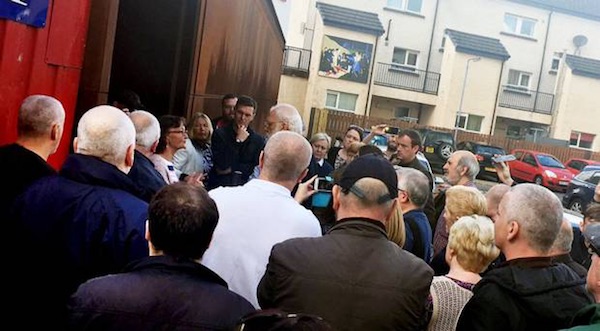
A protest was held on Friday afternoon, June 2, over the inclusion of the names of British soldiers and RUC members killed during the conflict in an installation at the Museum of Free Derry.
Margaret Wray, whose brother Jim Wray was one of the teenagers shot dead on Bloody Sunday, has said she is demanding artefacts currently housed at the museum be returned to her family, including the jacket with the bullet holes he was wearing that day.
The furore is over a new installation which includes a video to list the victims of the conflict between 1969-1972, including the names of the British occupying forces.
Scores of protesters gathered at the entrance to the museum on Friday afternoon to call for the names and details of British soldiers and RUC personnel to be removed. A small number also gathered to support their inclusion.
The attempt to create a single narrative of the conflict mirrors efforts by the Dublin government to pay tribute to British soldiers who died during Ireland’s freedom struggle alongside those Irish heroes who died or were executed by British forces.
A petition with 1,000 names was handed into the Derry museum earlier this week over their installation.
Speaking during the protest, Margaret Wray said: “Nobody wants peace as much as me and wants the true history recorded, but there is a place for everything, and policemen’s names and British soldiers’ names - that museum is not the place for it, where my grandmother’s windows were shot in that day in that very building, and my brother was just up there.”
She added; “I belong to no organisation or group. I want peace, I’m delighted with peace and I respect all cultures but this is not the place for the list of soldiers and RUC members here. Why are they doing that in here?”
She said if the list is not removed she will have the jacket her brother was wearing when he was killed returned to the family.
The organisers of the protest Brian Boyle, who has set up a ‘Not In Free Derry’ Facebook page, said he had received huge support for his stance, and said there would be more protests if the names are not removed.
“What we want is to be able to remember our dead without a reminder of those who occupied, tortured, maimed or murdered our friends and loved ones,” he said.
Kate Nash, whose 19-year-old brother William was among those shot dead on Bloody Sunday, called on the museum to remove the names immediately.
“It disgusts me that they are remembering British soldiers and police officers when my brother was murdered by British soldiers right outside their front door. I would ask the Bloody Sunday Trust to take these names down,” she said.
Jean Hegarty, who works for the Bloody Sunday Trust which owns the museum, said there were British Army personnel who had died in the same place in the same period. Ms Hegarty said: “It is something we cannot, in telling the truth of the events, ignore. We just cannot do that.”
The Museum of Free Derry said it is “totally unrepentant” about including those names, which it says it had always displayed. The museum received half a million pounds in state funds last year.
A spokesperson for the Bloody Sunday Trust said they would consider the petition, but insisted:
“It is clear from the displays within the Museum that we are highly critical of the role of the British Army and RUC in Derry. It is what the Museum is about telling the story of the Free Derry from the perspective on those who lived through it.
“This display of the names of the dead had been part of the museum for the past ten years. We have never received one single complaint until now.”
![[Irish Republican News]](https://republican-news.org/graphics/title_gifs/rn.gif)
![[Irish Republican News]](https://republican-news.org/graphics/title_gifs/harp.gif)

